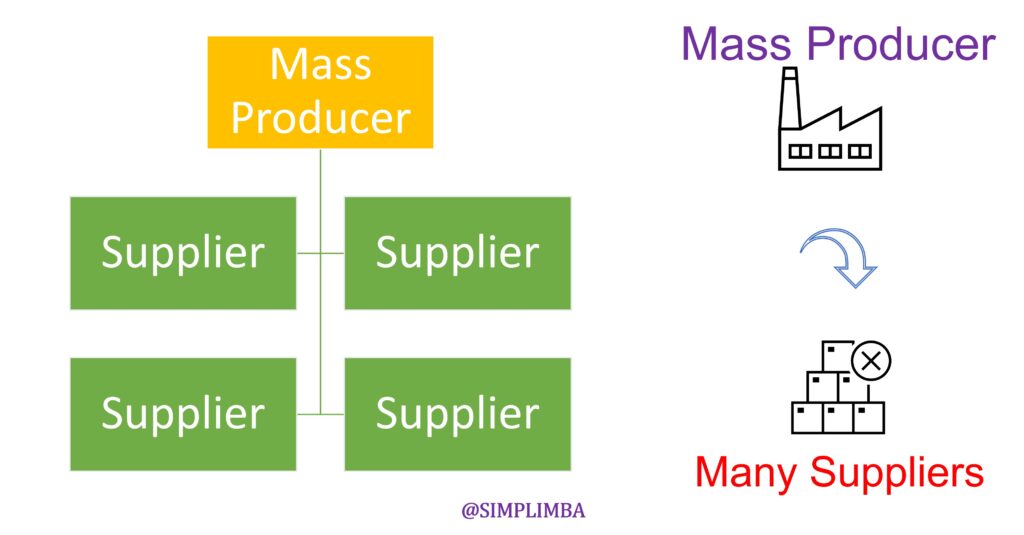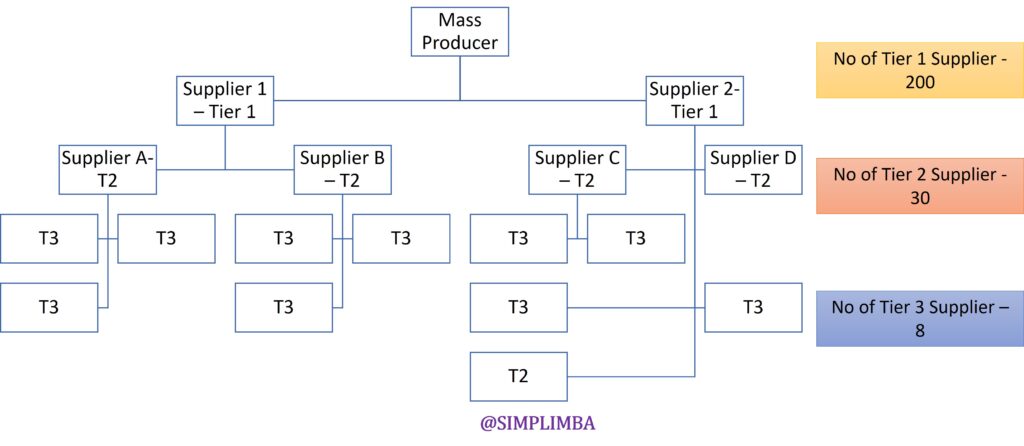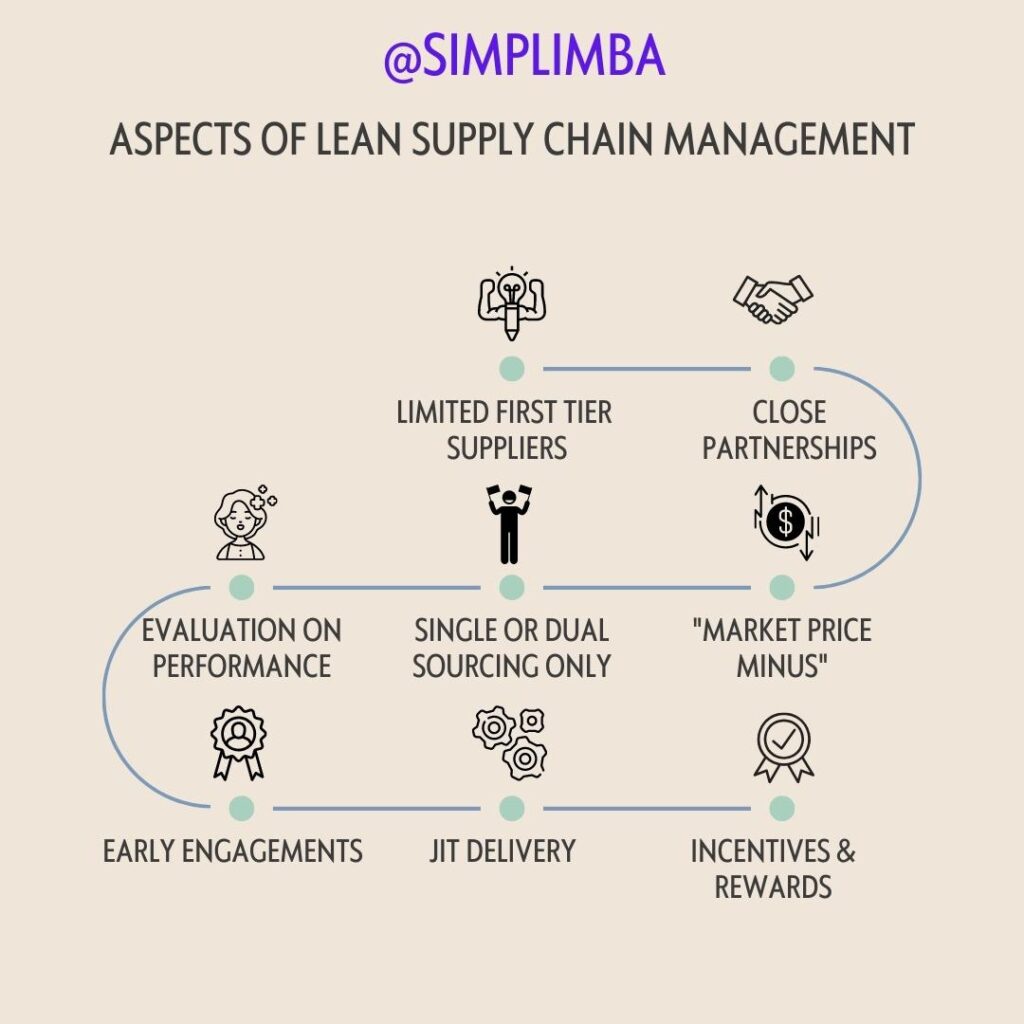Definition
Lean supply chain management focuses on the elimination of waste from the waste. In a nutshell, lean supply chain management is all about streamlining your company’s supply chain in order to eliminate waste and improve efficiency. By reducing or eliminating non-value-added activities throughout the supply chain, lean supply chain management can help your company save time and money while also improving customer satisfaction. Lean supply chain management examples would be companies like Toyota, IKEA, and Walmart who have achieved mastery in eliminating waste from every aspect of the supply chain
Historical Background
From the 1950s to the 1980s, Toyota led the Japanese auto industry to create a unique production/manufacturing system that turned it into the world’s largest auto exporter. The Toyota Production System (TPS) is now called lean manufacturing. Lean was first coined in MIT’s International Motor Vehicle Programme (IMVP) (Massachusetts Institute of Technology). The program focused on Japan’s unanticipated competitive advantages over the U.S. and Europe. Many books and articles have covered the program’s findings. “The Machine that Changed the World” defines ‘lean’ as we know it.
Lean manufacturing is a production management system developed by Toyota and refined by scholars and practitioners worldwide. Lean manufacturing distinguishes itself from mass production by reducing waste and error and manufacturing in small batches. Japan’s highly skilled workforce drives the system’s success. Lean means doing more with less.
A business philosophy for identifying and eliminating waste. It’s also customer-driven and adds value to the customer and business.
Lean manufacturing wasn’t created overnight. Years of relentless drive, continuous improvement, and trial-and-error perfected a working system. Lean manufacturing focuses on people, particularly shopfloor operators, to improve management. Active workers make a quality circle and TPM work. Lean Manufacturing emphasizes customer value.
The entire production system is driven by demand, not forecasts. Customized products and more customer options result. Lean manufacturing uses employee intellectual property. Everyone is encouraged to suggest improvements and can stop the assembly line if something is wrong. High commitment, hard work, well-educated workers, and company loyalty are our company values.
Lean manufacturing optimizes organizations and supply bases, not functional silos. It promotes close partnerships with first-tier suppliers and distribution channel partners. It tiers supply bases. Waste between organizations, previously ignored, is a key improvement area. Modular car design fits a tiered supply structure. Overall, the lean system has transformed supply chain management or ‘lean supply management.
Lean Supply chain management principles
Because the entire lean manufacturing system was initially derived from an inherited mass production system, the lean supply chain management practice in mass production is the best place to start when trying to understand what makes lean supply chain management unique and how it operates. In the supply system for mass production, the mass producer purchases the basic components for their products from a large supply base. When you consider that a contemporary automobile will have more than 20,000 fundamental components built into it, the number of suppliers will typically reach between 5000 and 8000. The figure below illustrates how the mass supply structure is almost completely flat. The mass producer is responsible for the assembly of not only the entire vehicle but also a significant number of its subsystems and modules. As a result, the amount of outsourcing is not particularly high.

The mass producer will be responsible for designing the components that will be manufactured by the suppliers. The procedure consists primarily of a sequential order of one step at a time, beginning with the design stage and continuing through the bidding, prototype, check, contract, and production stages. When using this system, finding and selecting a supplier will always begin with determining the cost of the service or good. The bid will go to the person who can produce the identical component at a lower cost. This will typically result in a situation where the suppliers will quote a low price in the hopes of winning the bid, and then they will anticipate raising the price through the process of annual price adjustment. The only pieces of information that suppliers are willing to divulge to buyers are the product’s price and volume.
The mass supply system has led to a consequence that is not in the least bit beneficial. When the supplier was brought into the production too late, even they had better ideas on how the design should have been; however, it was too late to make any changes. It’s possible that the buyer never had any intention of putting the suppliers’ expertise to use in the design of the vehicle in the first place. When a buyer applies intense cost pressure to their suppliers, it is detrimental because the buyer will often play off of the suppliers, which makes the suppliers reluctant to share product information. Because of this, it was impossible for the buyer to make an accurate estimate of the cost of producing the parts. Once the manufacturer has increased the effectiveness of its production, there is no longer an incentive to merge the learning curve (to share the saving). As a consequence of all of these factors, the cost of the parts was high, and their quality was inadequate.
The Japanese have, over the course of their history, developed an entirely new set of business practices known as the lean supply management system (Figure below). They can be summed up in ten lean supply principles, which stand in stark contrast to the tenets of the mass supply system that were previously in place.

Aspects of Lean Supply chain management

1) Supply from a more limited first-tier supply base: As shown in the figure above, the lean producer utilizes a large number of suppliers; however, it organizes its management of these suppliers into a tiered structure. The suppliers who provide goods or services directly to the buyer are known as first-tier suppliers. The lean producer now deals directly with this group of first-tier suppliers, and it is from this group that the lean producer obtains all of its supply of subsystems, modules, and components. As a result, the group of first-tier suppliers is referred to as the supply base.
Between two hundred and two hundred and fifty different suppliers make up the supply base for the lean structure. The mass supply system used to have significantly higher levels, but these current levels are significantly lower. The use of a small supply base is a distinct supply chain configuration that is shared by all lean supply chain management systems. This structural change has resulted in a plethora of behavior changes throughout the supply chain, all of which really deliver benefits.
2) Establish an appropriate and usually close partnership: The lean producer is able to spare more time and other resources to interact with each and every one of the first-tier suppliers because they use a much smaller supply base. This allows the lean producer to develop appropriate and usually close partnerships. Because of this, it has become possible for the buyer and the suppliers to have a more intimate working relationship.
In most cases, the close partnership will involve the following shared vision and mission, joint design and development of new products, strategically collaborated capital investment planning, capacity synchronization, coordination on just-in-time delivery, and inventory optimization are all examples of what can be accomplished when people work together. In most cases, the contractual terms for the suppliers range anywhere from the medium to the long term. Communication and participation occur on multiple levels, and with equal regularity, in both formal and informal settings.
3) The selection of suppliers is based on performance rather than price: when a lean producer chooses its suppliers, price is no longer the only criterion, nor is it the most important criterion, as a mass producer will do. Instead, the lean producer chooses its suppliers based on how well they perform. Ranking and selection decisions made by Lean producers will be based on a number of higher-level performance-focused criteria, such as quality standard, R&D capability, delivery reliability, management system and standard, commitment, and relationship. The price will be taken into account as one of the criteria, but it will always be evaluated in relation to the value that the company can provide. In Chapter 6, we will go over the specifics of the supplier selection process. Once they have been chosen as suppliers, the lean producer will treat them as “family members” and enforce a culture that is open to trust and relies on open communication.
4) Single or dual sourcing only: A lean supply chain management producer will typically favor the strategy of “single sourcing” or “dual sourcing,” rather than “multiple sourcing.” When a company uses single sourcing, it means that it will only buy the product (with its own unique SKU) from a single supplier. This indicates that there is neither a backup supplier nor a duplicate supplier for the product in question. When compared to the strategy of using multiple sources, the single-sourcing approach has a number of important advantages. It brings all of the volumes to a single supplier so that the unit cost can be reduced to its absolute minimum; in this way, the supplier can take advantage of economies of scale.
Dealing with two different companies for the same product design could lead to unnecessary complications. This solution offers the convenience and focuses needed when research and product development are required. It is helpful in the development of close partnerships; the act of contracting the product to a single supplier is, in and of itself, a clear statement of trust and the beginning of a partnership.
The use of a single source for all of a company’s procurement needs does, however, present a number of potential dangers. The potential for disruption in supply, regardless of its cause, is a potential problem, and the absence of alternative options may encourage complacency.
5) “Market price minus” rather than “Supplier cost plus”: Lean supply chain management takes a very different approach to the problem of pricing than traditional supply chains do. In a mass supply system, the price of the component that is being supplied is typically determined by the unit cost that the supplier incurs in order to produce the component, in addition to the profit margin that the supplier needs to achieve. This is an example of what is referred to as “supplier cost plus (margin)” pricing. The fact that the vendor’s cost model is simply accepted without being questioned is one of the issues with this strategy.
It is possible for uncompetitive supplier costs to make their way into the supply chain, which would then compromise its ability to remain competitive. The approach known as “market price minus” is utilized by lean supply management producers. It first determines the market price of the supplied component through market research and benchmarking; next, it deducts (subtracts) the agreed-upon reasonable profit margin that the supplier needs to make on each unit; finally, it calls the amount that is left over the ‘target cost.’ In the event that the target cost is lower than the actual cost incurred by the supplier, the buyer and the supplier will collaborate in order to bring the cost down to the level necessary to meet the target cost.
Both the current price of the good or service on the market and the profit margin for the supplier are protected in this manner. This also ensures that all of the prices along the supply chain are competitive with the market, which in turn ensures the success of the product.
6) Early and close engagement with suppliers for new product introductions: In a mass supply system, the new product introduction is solely designed by the mass producer, who is also known as the buyer. The supplier’s job is to simply make it according to the blueprint given, and the supplier does not have any involvement in the design stage.
The lean supply management system makes the decision to identify its suppliers first, and then involve them in the design and planning stage of the new product launch. In this way, the suppliers will have plenty of opportunities to contribute their expertise to the design, and by collaborating with the engineers provided by the buyer, innovation and new ideas can be generated in a manner that is significantly more productive. It is possible for the engineers from the supplier to work at the location of the buyer as the ‘residential engineer,’ acting as if the two businesses are one and the same.
By approaching the design process in this manner, numerous production and engineering issues that may arise later on can be avoided in the early stages of the design process. Collaboration and integration throughout the supply chain are important aspects of this process.
7) Synchronized flexible capacity: In the lean supply chain management system, the assigned capacity for both suppliers and buyers is not permanently fixed. This is due to the fact that a permanently fixed capacity will either be over-capacitated when the demand is low, or it will be under-capacitated when the demand is high.
More importantly, the capacities of the various suppliers and buyers along the supply chain should ideally be synchronized in order to achieve the maximum possible efficiency in the supply chain. A streamlined supply chain that is based on a flexible capacity that is largely synchronized. The ability to adapt one’s production methods at every stage of the supply chain is essential. This capacity flexibility refers to the ability to quickly increase or decrease production levels, as well as the ability to swiftly shift production capacity from one product or service to another.
Such adaptability can be accomplished by implementing plans, procedures, and workers that are adaptable, in addition to employing strategies that make use of the capabilities of other organizations.
8) Just-in-time delivery, also known as JIT: JIT is an approach to lean manufacturing that is well known. It is the central tenet of lean manufacturing and supply chain philosophies, as well as one of its defining characteristics.
The Just-In-Time (JIT) method of material control is predicated on the idea that a process should only be carried out when a customer indicates a need for additional parts that were produced by that process. When a process is run in a JIT manner, it allows for the production of goods and the delivery of those goods just in time for them to be sold.
This guiding principle applies to all aspects of lean supply chain management. The production of parts and their delivery just in time for assembly into subassemblies is referred to as just-in-time manufacturing. The demand from the end user is what serves as the impetus for getting work started across the entire supply chain. One way to think about lean supply chain management is as a chain of customers, with each link in the chain being coordinated with its neighbors by just-in-time signals.
The demand placed by the final customer in the marketplace acts as the impetus for the entirety of the supply chain. A pull system is characterized by the flow of materials and goods through the supply network. This system is described as having these characteristics. In response to the demand placed by the final customer, components move backward through the supply chain.
9) Alignment of incentives and rewards: The lean supply chain management places a significant amount of emphasis on the alignment with the suppliers through the use of incentives and rewards. The goal of the lean producer, in their role as the buyer, is not to siphon off a portion of the profit made by the supplier, but rather to collaborate with the supplier in order to bring down the costs, so that together they can construct a more robust supply chain.
We will recognize and appreciate the contributions that our suppliers made toward the reduction in costs, and we will offer them incentives. In most cases, when a supplier makes a certain amount of savings through the implementation of efficiency improvements, the supplier will keep fifty percent of those savings for themselves rather than passing the savings on to the buyer in the form of reduced component prices.
Any contributions made toward a better design or an improvement in quality will be rewarded with an increase in business. This strategy not only improves the alignment of the value added to the reward but also significantly boosts the suppliers’ motivation and commitment to the process of developing a competitive supply chain.
10) Willingness to share a significant portion of its proprietary information: The lean supply chain management also represents a culture of mutual trust and loyalty at the very least and typically within the supply chain. There is a willingness on the part of suppliers to disclose substantial amounts of confidential information to buyers.
Not only does this openness and trust make the supply chain significantly more visible, making it much easier to coordinate, but more importantly, it creates synergy between the parties involved. The value of information rises when it is disseminated to a wider audience and utilized by more people.
Samrat is a Delhi-based MBA from the Indian Institute of Management. He is a Strategy, AI, and Marketing Enthusiast and passionately writes about core and emerging topics in Management studies. Reach out to his LinkedIn for a discussion or follow his Quora Page
